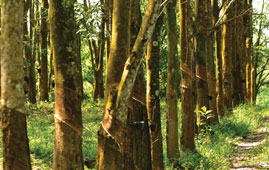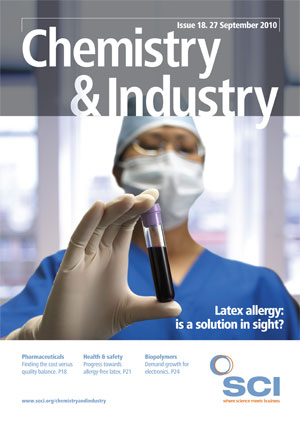Erasers, rubber bands, condoms, balloons, hot water bottles, stress balls, washing up gloves… It is estimated that 1-6% of the UK population is sensitised to natural rubber latex (NRL), although not all of them may develop symptoms, according to the Latex Allergy Support Group (LASG). That figure also includes about 17% of healthcare workers – mostly sensitised as a result of exposure to latex gloves.
Individuals with Type 1 latex allergy, to the proteins found in NRL, suffer the most severe symptoms, which can be life-threatening. And since there is no known limit on a safe lower level of latex – a billionth of a gram (1ng) has been reported to elicit a reaction – avoidance is the only guarantee against the possibility of an adverse reaction.
While alternative synthetic materials are available, many medics prefer the comfort and fit of NRL, especially for delicate surgical procedures, which require a high degree of dexterity. And since gloves made from vinyl, nitrile or neoprene also usually contain many of the same chemicals used during the manufacture of NRL gloves – often at higher levels – they can also give rise to the other common form of latex allergy, Type 4 contact dermatitis. Indeed, according to a 2008 latex allergy report by the Royal College of Physicians: ‘It is conceivable that changing to latex alternatives may only substitute one set of problems for another’.
Although levels of proteins in NRL gloves used by the healthcare sector have reduced dramatically over the past three decades since Type 1 latex allergy became an issue, a truly hypoallergenic latex glove is still some way off. ‘The question always remains: how do you prove ‘allergen free’ with enough confidence to make a 100% guaranteed claim?,’ asks Haydn Williams, an independent medical device technical consultant and LASG adviser. ‘Not all allergens can be guaranteed to be covered by the assay methods and the extreme sensitivity of some allergy sufferers is beyond any assay sensitivity.’

Ansell Healthcare, for example, reports that it now regularly uses the FITkit test to measure the latex allergen content of its gloves. According to spokesperson Oliver Trop, the firm’s range of Gammex medical gloves all have levels of allergenic proteins below the limits of detection even by FITkit, at less than 0.05 microgram/g. In Finland, meanwhile, where the FITkit assay was developed, Williams points out that researchers monitoring allergen levels in gloves on sale in the country have found many with very low allergen levels. ‘Unofficially, many experts believe that any of these low protein latex gloves can be used – even by the sensitised,’ Williams says. ‘Indeed it is likely this is happening in practice. However, no-one is going to underwrite such a proposition for fear of potential litigation should some sort of reaction occur.’
One company that is now looking to challenge the current legislation over latex allergy, however, is Dutch R&D company Budev. In July 2010, the firm reported the results of allergy tests of latex material produced using its proprietary MPXX technology against actual blood samples from latex allergy sufferers – a method known as a RAST inhibition test, carried out by an independent testing organisation in Germany. ‘All results were negative, which means a very positive result for us,’ commented a company spokesperson, adding that ‘due to current legislation, we are not allowed to use the term “latex allergy free”, although having the FITkit results [showing unquantifiable levels of proteins] together with the blood test results … we shall have a very strong case to fight the latexallergy problem.’
While the exact details of Budev’s MPXX technology are still under wraps, ceo Michiel Paping describes it as a kind of laundry service for latex, capable of ridding gloves or other massproduced latex products of allergenic proteins after they are produced. Unlike other latex washing procedures, used, for example, to produce surgical gloves such as Gammex, Paping says he expects the MPXX technology to be more efficient and applicable ultimately to all types of latex products, not just medical gloves. ‘We see it as a method that could potentially be used for any NRL product in the world – toys, balloons, catheters, condoms, bikinis…’

However, Williams remains cautious about the results of both FITkit and blood testing methods. While a blood test would rule out the possibility of allergic reaction for any particular individual, he warns that there is no guarantee that other allergy sufferers would be sensitised in exactly the same way. Moreover, ‘European efforts to validate the [FITkit] method using a Round Robin multi-lab study were unsuccessful,’ he says, which is one reason EU regulators have refused to add the method to the usual list of approved protocols. Also, he points out that ‘there may be other allergens of concern apart from the four measured by FITkit.’
Greater risk for latex allergy sufferers
Currently, meanwhile, a greater risk for latex allergy sufferers comes from powdered latex gloves, which are still sold in the UK for general household use and in non-medical sectors, Williams says. The powder – typically starch – while helpful for taking gloves on and off, mobilises the proteins in the latex and transports them more easily onto the skin, as well as potentially putting non-glove wearers at risk by carrying the protein allergens into the surrounding air.
The most common powder-free glove manufacturing process involves leaching and chlorination, which reduces the levels of extractable proteins and renders the latex surface less tacky. However, an alternative method by Mölnlycke Health Care uses enzymes to remove proteins from the raw material, which also has the effect of making the gloves softer and avoids the need to add moisturisers, explains Mölnlycke spokesperson Torbjörn Turland. The company’s Biogel range of latex gloves typically have protein levels of below 20 microgram/g, Turland says, although the latest Eclipse range contain less than 40 microgram/g proteins owing to tweaks in the process to make the gloves even softer. The Biogel inner glove coating also differs from that of other glove manufacturers, Turland says. ‘Other manufacturers add moisturisers such as Aloe vera but we don’t have to do that as the Biogel inner coating naturally allows the hands to breathe as tiny pockets of air are captured when you put your hands in the gloves.’
Mölnlycke is also about to launch the first non-latex glove that is free from the allergy causing accelerators that cause Type IV allergic contact dermatitis, Turland points out. ‘Typically manufacturers use more accelerators in manufacturing non-latex gloves as synthetics are intrinsically weaker than natural latex,’ he explains. ‘Data sheets show [NRL] is stronger and more resistant to tearing and punctures than non-latex materials and it is also regarded as the best barrier to prevent against the transmission of blood-borne pathogens such as viruses.’
The new non-latex gloves are expected to be especially popular for the US market, Turland says, where there is currently a ‘huge change to non-latex, which previous experience suggests may lead to an increase in the number of people developing Type IV allergic contact dermatitis as a result.’
Another often overlooked advantage of NRL, meanwhile, is that it is renewable ‘and 100% biodegradable’, obtained as a milky latex concentrate from the Hevea brasiliensis tree, points out Bill Doyle, ceo of US latex manufacturer Vystar. One of the drawbacks of modern manufacturing processes for dipped latex products such as gloves, however, is that they frequently involve repeated cycles of washing and/or leaching to reduce the levels of allergenic proteins, Doyle says, which uses copious amounts of water and energy.
Vystar’s Vytex NRL avoids the need for these secondary washing processes, he explains, as it is made by a modified manufacturing process in which a protein binding agent – aluminium hydroxide – is added to remove the proteins during the actual process of latex manufacture. A study at a latex glove plant in India – producing 10,000 pairs of gloves/day – found that switching to the modified NRL process saved 21.6 kL/day of water and 396,000 kcal/kWh, saving the company $472,500/year, Doyle says. But while levels of antigenic proteins in Vytex NRL made products are claimed to be reduced by 95%, compared with conventional NRL, nevertheless allergenic proteins may still be present.
With an estimated 40,000 products made from NRL currently on the marketplace, Doyle says that ‘NRL use is predicted to increase substantially due to its green nature as a natural product and a growing global movement. ‘It is very sustainable. The Hevea brasiliensis tree takes seven years to grow and you can tap if for 25 years before the tree is cut down and you can plant a new tree in its place.’
And, since he estimates that the current market for NRL – excluding the tyre industry – is already worth somewhere in the region of $3bn, that leaves a huge potential market for latex producers quite literally to tap into.





